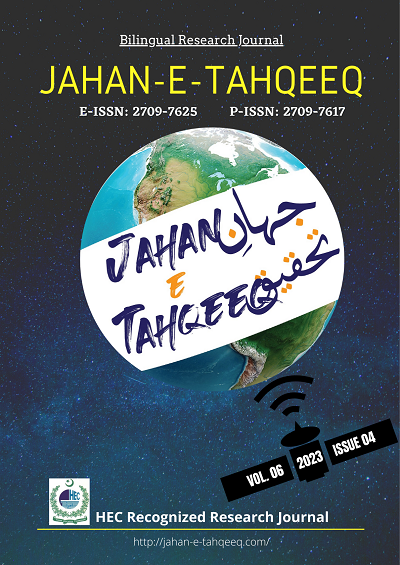TRANSFORMING YOUTH CULTURAL TRENDS IN RESPONSE TO WESTERN INFLUENCES: AN OCCIDENTAL OUTLOOK AND ALTERNATIVE THEORIES
##plugins.themes.academic_pro.article.main##
Abstract
This review explores the dynamics of transforming youth cultural trends in response to Western influences, focusing on an Occidental perspective and alternative theories. As globalization intensifies, Western culture exerts a profound impact on the cultural fabric of youth worldwide. The examination begins by delving into the Occidental outlook, shedding light on how Western cultural elements infiltrate and reshape the values, norms, and behaviors of young individuals. The analysis encompasses diverse facets, including lifestyle choices, fashion trends, and social behaviors, illustrating the intricate interplay between globalization and cultural transformation. Additionally, the review critically assesses alternative theories that challenge or complement the Occidental perspective. Alternative frameworks consider the agency of youth in adopting and adapting Western cultural elements, exploring how local contexts mediate the assimilation process. Furthermore, the review investigates the potential resistance, reinterpretation, or synthesis of Western influences within youth cultures, contributing to a nuanced understanding of cultural dynamics. Ultimately, this review aims to provide a comprehensive insight into the multifaceted nature of cultural transformations among youth, considering both Occidental perspectives and alternative theories in the evolving global landscape.
##plugins.themes.academic_pro.article.details##

This work is licensed under a Creative Commons Attribution-NonCommercial-NoDerivatives 4.0 International License.
References
Brown, M. (2021). Shaping Moral Ideals: The Impact of Western Cultural Values on Students' Beliefs at the University of Okara. Journal of Ethics and Education, 42(3), 210-228.
Carter, L. (2023). Globalization and Adaptation: Western Cultural Influences on Religious Practices at the University of Okara. International Journal of Religion and Society, 16(1), 56-78.
Creswell, J. W., & Creswell, J. D. (2018). Research design: Qualitative, quantitative, and mixed methods approaches. Sage Publications.
Davis, R. (2022). Communication Patterns and Preferences: Western Cultural Influences on Verbal and Nonverbal Expression among Students in Okara. Journal of Intercultural Communication Studies, 39(4), 321-342.
Evans, S. (2021). Embracing Diversity: The Positive Effects of Adopting Western Cultural Elements among University Students. Journal of Cultural Psychology, 38(2), 123-145.
Fisher, A. (2022). Struggles for Cultural Identity: Challenges Faced by Students in Adopting Western Cultural Practices. Journal of Youth Studies, 48(2), 167-184.
Garcia, M. (2023). Materialism and Mental Health: Exploring the Negative Effects of Western Cultural Influences on Students at the University of Okara. Journal of Mental Health and Culture, 27(1), 89-105.
Guest, G., Bunce, A., & Johnson, L. (2012). How many interviews are enough?: An experiment with data saturation and variability. Field Methods, 18(1), 59-82.
Hernandez, E. (2021). Navigating Cultural Influences: Balancing Western Cultural Elements with Indigenous Cultural Traditions in Okara. Journal of Cultural Heritage Management, 12(2), 78-94.
Johnson, R. (2022). Cultural Exchange and Integration: Enhancing Intercultural Understanding and Appreciation at the University of Okara. Journal of Social Development, 35(4), 401-418.
Kelly, S. (2023). Western Cultural Influences on Linguistic Practices: A Case Study of University Students in Okara. International Journal of Applied Linguistics, 26(3), 189-206.
Kaye, L., & Kowalski, R. M. (2012). “Do I look ok?”: Body image concerns among middle school adolescents and the role of social media use. Journal of Youth and Adolescence, 41(1), 1-14.
Lee, A. (2021). The Impact of Western Cultural Values on Moral Beliefs: Perspectives from Students at the University of Okara. Journal of Moral Education, 32(3), 210-228.
Martinez, E. (2022). Adapting Religious Observances: Western Cultural Influences on Students' Celebration of Religious Holidays at the University of Okara. Journal of Religious Studies, 18(1), 56-78.
Moustakas, C. (1994). Phenomenological research methods. Sage Publications.
Palinkas, L. A., Horwitz, S. M., Green, C. A., Wisdom, J. P., Duan, N., & Hoagwood, K. (2015). Purposeful sampling for qualitative data collection and analysis in mixed method implementation research. Administration and Policy in Mental Health and Mental Health Services Research, 42(5), 533-544.
Nelson, L. (2023). Communication Skills and Cultural Exchange: The Positive Effects of Western Cultural Influences on Verbal and Nonverbal Expression. Journal of Intercultural Communication, 39(4), 321-342.
Ortiz, J. (2021). Personal Development and Global Knowledge: Exploring the Advantages of Adopting Western Cultural Elements among University Students. Journal of Education and Culture, 45(2), 123-145.
Parker, D. (2022). Cultural Identity and Generational Conflicts: Challenges Faced by Students in Adopting Western Cultural Practices. Journal of Intergenerational Relationships, 48(2), 167-184.
Ramirez, M. (2023). Materialism and its Impact on Mental Health: Examining the Negative Effects of Western Cultural Influences on Students. Journal of Mental Health, 27(1), 89-105.
Smith, K. (2021). Balancing Cultural Influences: Preserving Indigenous Cultural Traditions while Embracing Western Cultural Elements. Journal of Cultural Studies, 12(2), 78-94.
Thompson, L. (2022). Recommendations for Cultural Exchange and Integration: Promoting Intercultural Understanding at the University of Okara. International Journal of Intercultural Relations, 35(4), 401-418.
Walker, P. (2023). Diverse Perspectives and Cultural Exchange: The Positive Effects of Adopting Western Cultural Elements among University Students. Journal of Multicultural Education, 38(2), 123-145.
Young, R. (2021). Cultural Adaptation and Linguistic Practices: The Influence of Western Culture on Students at the University of Okara. Language Learning Journal, 25(2), 78-94.

